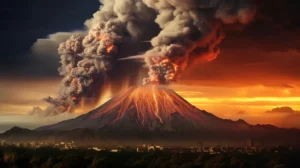 Sicily skyline turned into a dramatic display of fire and smoke early Monday morning as Mount Etna, Europe’s most active volcano, erupted with force, sending a towering cloud of ash and molten fragments into the atmosphere. The eruption which began with a sudden burst of pressure within the mountain’s crater, created a plume that stretched several kilometres into the sky and could be seen for miles.
Sicily skyline turned into a dramatic display of fire and smoke early Monday morning as Mount Etna, Europe’s most active volcano, erupted with force, sending a towering cloud of ash and molten fragments into the atmosphere. The eruption which began with a sudden burst of pressure within the mountain’s crater, created a plume that stretched several kilometres into the sky and could be seen for miles.
Despite the eruption’s intensity and visual spectacle, authorities reported no injuries or damage. Air travel to and from the island experienced minimal disruption, and local monitoring agencies confirmed that the volcanic activity had subsided by evening. While residents and tourists marveled at the scene, scientists observed the event with a mix of familiarity and caution.
Understanding the Mechanics Behind the Eruption
The eruption was triggered by increased internal pressure that led to the partial collapse of one of Etna’s summit craters. This collapse released a pyroclastic flow a dangerous, high-speed avalanche of hot gases, ash, and rock fragments that surged down the volcano’s flanks. Soon after, lava began pouring out, flowing in three distinct directions before gradually cooling.
Italy’s National Institute of Geophysics and Volcanology captured the spectacle using thermal imaging, revealing glowing rivers of lava winding their way down the mountain’s slopes. Experts concluded that while Etna’s latest activity was powerful, it remained within the range of normal behavior for the volcano.
Is It a Strombolian Eruption? Not Quite
Mount Etna is often associated with Strombolian eruptions a type of relatively mild volcanic activity characterized by regular bursts of lava, gas, and cinders. Named after the nearby Stromboli volcano, these eruptions typically produce rock fragments that travel short distances and rarely result in large-scale pyroclastic flows.
However this week eruption was more explosive than typical Strombolian events. The presence of pyroclastic flows and the rapid collapse of the crater suggest that the eruption exceeded the usual parameters, pushing Etna’s activity toward a more volatile classification.
Forecasting Volcanic Activity: How Far Have We Come?
Predicting volcanic eruptions remains a complex challenge. Volcanologists use a combination of seismic monitoring, satellite imaging, and gas analysis to anticipate eruptions. As magma rises toward the surface, it can cause small earthquakes, bulging of the ground, and shifts in volcanic gas emissions all signs that an eruption may be imminent.
Mount Etna, like many closely watched volcanoes around the world, benefits from advanced monitoring technology. These systems not only help scientists understand volcanic behavior in real time but also give local authorities the information needed to issue timely warnings and ensure public safety.
Are Volcanic Eruptions Increasing?
While it may seem that eruptions are becoming more frequent, experts assert that this perception is largely due to improved monitoring and faster dissemination of news. With satellites, seismic stations, and global news outlets covering even minor volcanic activity, the world is simply more aware of each event.
Mount Etna, situated in a highly studied region, has been erupting regularly for thousands of years. Its frequent activity makes it a crucial site for volcanological research, helping scientists refine prediction models and deepen their understanding of Earth’s geologic processes.
Though Etna’s latest outburst has ended, volcanologists will continue to monitor its activity closely. For tourists eager to witness the awe-inspiring power of a volcano, experts advise respecting local warnings and staying informed. Eruptions like these serve as vivid reminders of nature’s raw power and the importance of science in helping us live safely alongside it.
